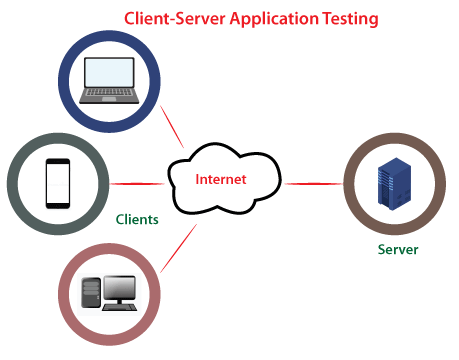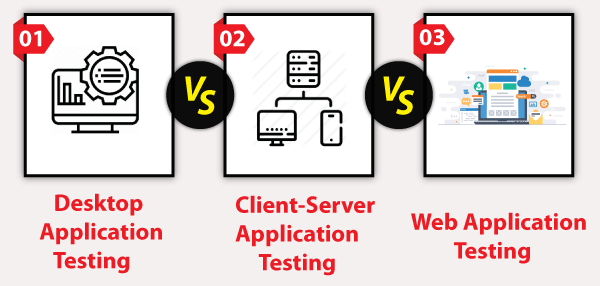The Differences Between Desktop Application testing, Client-Server Application Testing and Web Application TestingIn software testing, we have three different types of applications testing, such as:
These software applications are being developed and created precisely to perform in different circumstances and areas. All of the applications mentioned above relates to different environments where they can be tested individually and differently. In other words, we can say that the crucial aspect of this type of testing is the environment in which they are tested. The user loses control over the environment entirely when the end-user continues from one testing type to another. In this tutorial, we are going to understand the difference between these (Desktop, Client-Server, and Web Application Testing) types of applications. But before we go through the difference between them, firstly, we will see the brief introduction of Desktop, Client-server, and Web applications testing. What is Desktop Application Testing?The first type of software application is the Desktop application. In a desktop application testing, the entire software is installed at the end-user machine, and only one user can access it at a time. The desktop application is further known as a Stand-alone application testing. Basically, it is executed on personal computers, machines, and systems. In order to test the desktop application, we must know the operating system and database and how the user interacts with the application. 
These types of applications concentrate only on the specific environment. The desktop application includes the analysis of the application entirely in elements such as Graphical User Interface (GUI), functionality, backend, database, and load. And the end-user also needs to identify the different methods to test the memory leaks and unhandled exceptions. Advantages of Desktop Application testingFollowing are some of the significant advantage of desktop application testing:
Disadvantages of Desktop Application testingSome of the vital drawbacks of desktop application are as follows:
What is Client-Server Application Testing?Client-server application is another type of software application. These types of applications are single-user applications, which execute on two or more systems and knowledge of networking is needed while executing the client-server applications. 
Basically, in the client-server application, we will test the application graphical user interface on both the systems such as server and client and also test the functionality, load, database, and communication between client and server. The end-user needs to identify the load and performance issues and also work on the code space under the Client-server application. In client-server types of application testing, we can obtain the test cases and test scenarios with the help of requirements and understanding. We can implement the following types of tests under the Client-server application:
Advantages of Client-Server Application testingFollowing are some of the significant advantage of Client-server application:
Disadvantages of Client-server Application testingSome of the vital drawbacks of Client-server application are as follows:
What is Web Application Testing?Web applications are applications where we test the application on different browsers and diverse versions of the same browser and different operating systems. And this type of application can be executed on two or more machines. In other words, we can say that the web-based application executes in a web browser instead of being installed on an end user's device. That means the entire software is installed at a server, and the end-user can access the particular application by using the URL. 
These applications are used to analyze the browser similarity and operating system compatibility, attributes such as performance, usability, back-end, Graphical User Interface, accessibility. These applications can by executed on any device that who has the internet connection such as desktop computers, tablets, and mobile phones. Web applications are easily accessible, support several browsers and devices, platform-independent, which help us decrease the cost compared to the other types of software applications. Web-based applications are more complicated and require comprehensive testing. To implement the web-based application, the test engineers need to know how the web application is communicating with the user. Understanding several technologies such as JavaScript, Php, debugging is also necessary while performing the web application testing. We can implement the following types of tests under the web-based applications:
Advantages of Web Application testingFollowing are some of the significant advantage of web application:
Disadvantages of Web Application testingFollowing are some of the most common disadvantage of web application:
Desktop Application VS Client-Server Application VS Web Application testingLet us significant differences between desktop, client-server, and web application's testing into the below table: 
ConclusionAfter seeing all the significant differences between desktop, client-server, and web application testing, we can conclude that all of these applications are entirely different and have various benefits and drawbacks. In simple words, we can say that if we are testing a stand-alone or desktop application, then the center should be environment-oriented because the stone-alone/desktop application is executed only in a precise environment. To check the application's usability, backend, load, and other functionality, we should perform the Desktop applications. On the other hand, in the client-server application testing, the user performance is predictable and manageable because Client-server applications do not need any browser as per the media in order to access the application. Whereas performing the Web application testing itself is a crucial process to make sure that the web application under test can be easily retrieved by the actual users and working appropriately throughout all the operating systems and browsers. To check the application's performance, features, accessibility, security, and usability, we should perform the Web applications. Nearly every test engineer works with applications such as Desktop/stand-alone application, Client-Server application, and Web Application Testing.
Next TopicActive Testing
← prev
 For Videos Join Our Youtube Channel: Join Now
For Videos Join Our Youtube Channel: Join Now
Feedback
Help Others, Please Share


|







